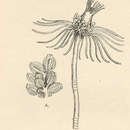en
names in breadcrumbs


Very little information was found on conservation of this species since it is not of threatened or endangered status. However, efforts are made to keep environmental conditions under control in order to maximize biodiversity.
US Federal List: no special status
CITES: no special status
Ectopleura crocea considered a nuisance species since it was introduced into the Atlantic environment approximately twenty years ago. (It was first found in the San Juan Islands in the 1930's but not discovered in the areas it inhabits now until the 1980's). Though most non-native species are unable to form self-sustaining colonies, if they do establish themselves, they can greatly affect the flora and the fauna of the ecosystem. Non-Indigenous Species (NIS) can bring disease and parasites to economically valuable native species and therefore adversely affect the economy. They also can compete for food with the native species or even use the native species as a food source, thus greatly altering the ecosystem (Mills 1998; Non-Indigenous Aquatic Nuisance Species (ANS),1998).
Ectopleura crocea feeds on zooplankton, phytoplankton and small detritus, thus helping to avoid build-up in the environment. Also, it is a food source for nudibranchs, echinoderms, and other fish that humans regularly consume, including cod, haddock and flounder (Animal Species in the Tillies Basin Area 2001).
The strength of the stinging power of Ectopleura crocea's tentacles paralyzes its prey and then the tentacles draw the food into the invertebrates' mouths. The food supply of Ectopleura crocea consists of zooplankton, phytoplankton and small detritus (CCS - Stellwagen Bank - Other Invertebrates (non-plankton));Animal Species in the Tilles Basin Area, 2001).
Ectopleura crocea, also known as Ectopleura crocea in the scientific community, is commonly referred to as the pink-hearted hydroid, or the pink-mouthed clustered hydroid. It lives mainly in the northwest Atlantic ocean, including the area around New England, though it can be found from New Brunswick to Florida. In the Chesapeake Bay, Ectopleura crocea is limited to the mouth of the bay and is most prevalent in the summer(WDFW 2001; Lippson 1984; Collins 1981 )
Biogeographic Regions: atlantic ocean (Native )
Ectopleura crocea grows profusely on rocks and boat docks. It does not, however, live in the intertidal zone, so it's not very likely that one would find Ectopleura crocea in this area though this invertebrate prefers a habitat consisting of gravel or sand (Animal Species in the Tillies Basin Area 2001).
Aquatic Biomes: benthic ; coastal
Hydroids are small (each about 400 micrometers in size), colonial animals that grow on rocks and seaweed and appear as "bushy growths." The hydroids appear as tufts of long and tangled stems. Individually, each hydroid has a stem-like feature, the pedicel, and a flower-like feature, the hydranth. Each hydranth has one row of tentacles around the central mouth and one proximal row, consisting of 16-25 shorter tentacles. Ectopleura crocea has gray stalks and pink hydranths, thus leading to its common names of "pink-hearted hydroid" or "pink-mouthed clustered hydroid," (Coelenterata 2001; Organisms of the Woods Hole Region 2001; Collins,Henry Jr. 1981).
Other Physical Features: ectothermic ; radial symmetry
In experimental studies, the larvae of Ectopleura crocea was observed to determine the importance of active and passive processes during its settlement. It was hypothesized that the larvae would have preferences of settlement based on topographic heterogeneity, that substratum complexity would modify these preferences and that behavior of the larvae on or close to the substratum mediates these preferences. All three hypotheses were found to be true. E. crocea larvae chose the most complex kind of panels and, for the most part, settled on surfaces that were the most exposed (Marine Ecology Progress Series 1996).
In asexual reproduction, the gonosomes (long stalks) of Ectopleura crocea grow between the rows of tentacles into a cluster-like structure. Male and female gonophores are made by different colonies located on the gonosomes. Sperm is located within the structure of the balloon-resembling male gonophore. The eggs and developing larvae are contained within the female gonophore. Only a few oocytes reach maturity, in the cycle of sexual reproduction of Ectopleura crocea. The sperm then enters these oocytes and the egg ripens to a size of about 400 microns. Cleavage can form either a coeloblastula or a solid morula. The fertilized egg, now an embryo, is changed into an oval body of cells which will eventually flatten to take on a disc-like shape. The embryo then elongates into the shape of a cylinder. The height of the polyp attached to this body increases quickly and buds grow off the sides of the shoot (Colenterata 2001).
Parental Investment: no parental involvement
The tubular hydroid (Ectopleura crocea) is a species of hydroid cnidarian, and is found in temperate coastal waters. It is a member of the family Tubulariidae.[1]
The tubular hydroid resembles a long-stemmed narrow-petalled flower. The stem is encased in a sheath. The polyps are pink or orange and white, with an outer ring of long tentacles. There are short tentacles surrounding the mouth rising from a cluster of yellow bead-like bunches of reproductive sporosacs.[2]
This species is native to the Atlantic coast of North America, and also occurs in the Mediterranean Sea, the northeastern Atlantic Ocean, South Africa, Australia, New Zealand, and the west coast of North America.[3]
Male and female sporosacs are on separate hydranths (feeding individuals) in the colony. These animals feed on tiny planktonic crustaceans.[4]
The tubular hydroid (Ectopleura crocea) is a species of hydroid cnidarian, and is found in temperate coastal waters. It is a member of the family Tubulariidae.